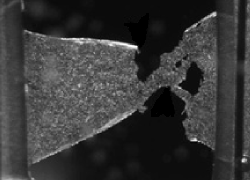
Citation
A. Bonfanti, J. Fouchard, N. Khalilgharibi, G. Charras and A. Kabla
Royal Society Open Science 7:190920 (2020)
Abstract
Abstract
The mechanical response of single cells and tissues exhibits a broad distribution of time-scales that often gives rise to a distinctive power-law rheology. Such complex behaviour cannot be easily captured by traditional rheological approaches, making material characterisation and predictive modelling very challenging. Here, we present a novel model combining conventional viscoelastic elements with fractional calculus that successfully captures the macroscopic relaxation response of epithelial monolayers. The parameters extracted from the fitting of the relaxation modulus allow prediction of the response of the same material to slow stretch and creep, indicating that the model captured intrinsic material properties. Two characteristic times, derived from the model parameters, delimit different regimes in the materials response. We compared the response of tissues with the behaviour of single cells as well as intra and extra-cellular components, and linked the power-law behaviour of the epithelium to the dynamics of the cell cortex. Such a unified model for the mechanical response of biological materials provides a novel and robust mathematical approach to consistently analyse experimental data and uncover similarities and differences in reported behaviour across experimental methods and research groups. It also sets the foundations for more accurate computational models of tissue mechanics.
Figure sample

Fractional viscoelastic model for epithelial monolayers: constitutive model and stress relaxation behaviour. (a) Diagrammatic representation of the fractional rheological model and qualitative behaviour of its stress relaxation modulus. The three-element fractional model is fitted to the relaxation data for (b) untreated epithelial monolayers (black curves are the experimental data, while the red curves represent the fit) and (c) monolayers treated with an inhibitor of contractility, Y27632 (the black curves are the experimental data, while the blue curves are the fits). Note that the monolayers are loaded with the constant rate of strain 75%/s and that the time is set to zero at the beginnings of the loading ramp.



